
Moeritherium is an extinct genus of primitive proboscideans. These prehistoric mammals are related to the elephant and, more distantly, sea cows and hyraxes. They lived during the Eocene epoch.

Sivapithecus is a genus of extinct apes. Fossil remains of animals now assigned to this genus, dated from 12.2 million years old in the Miocene, have been found since the 19th century in the Siwalik Hills of the Indian subcontinent as well as in Kutch. Any one of the species in this genus may have been the ancestor to the modern orangutans.

The billfish are a group of saltwater predatory fish characterised by prominent pointed bills (rostra), and by their large size; some are longer than 4 m (13 ft). Extant billfish include sailfish and marlin, which make up the family Istiophoridae; and swordfish, sole member of the family Xiphiidae. They are often apex predators which feed on a wide variety of smaller fish, crustaceans and cephalopods. These two families are sometimes classified as belonging to the order Istiophoriformes, a group which originated around 71 million years ago in the Late Cretaceous, with the two families diverging around 15 million years ago in the Late Miocene. However, they are also classified as being closely related to the mackerels and tuna within the suborder Scombroidei of the order Perciformes. However, the 5th edition of the Fishes of the World does recognise the Istiophoriformes as a valid order, albeit including the Sphyraenidae, the barracudas.

Hylonomus is an extinct genus of reptile that lived 312 million years ago during the Late Carboniferous period. It is the earliest unquestionable reptile. The only species is the type species Hylonomus lyelli. Despite being amongst the oldest known reptiles, it is not the most primitive member of group, being a eureptile more derived than either parareptiles or captorhinids.
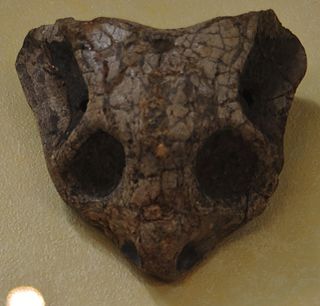
Cistecephalus is an extinct genus of dicynodont therapsid from the Late Permian of southern Africa. It was a small, specialised, burrowing dicynodont, possibly with habits similar to a modern mole. The head was flattened and wedge-shaped, the body long, and the forelimbs very strong, with similarities in structure to the forelimb of modern burrowing mammals.

Coccosteus is an extinct genus of arthrodire placoderm from the Devonian period. Its fossils have been found throughout Europe and North America. The majority of these have been found in freshwater sediments, though such a large range suggests that they may have been able to enter saltwater. It was a small placoderm, with Coccosteus cuspidatus measuring 29.6–39.4 cm (11.7–15.5 in) long.
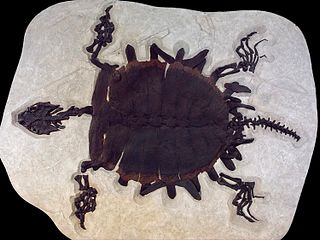
Axestemys is an extinct genus of softshell turtle that lived from the Late Cretaceous to the Eocene in western North America and Europe.

Protosphyraena is a fossil genus of swordfish-like marine fish, that thrived worldwide during the Upper Cretaceous Period (Coniacian-Maastrichtian). Though fossil remains of this taxon have been found in both Europe and Asia, it is perhaps best known from the Smoky Hill Member of the Niobrara Chalk Formation of Kansas. Protosphyraena was a large fish, averaging 2–3 metres in length. Protosphyraena shared the Cretaceous oceans with aquatic reptiles, such as mosasaurs and plesiosaurs, as well as with many other species of extinct predatory fish. The name Protosphyraena is a combination of the Greek word protos ("early") plus Sphyraena, the genus name for barracuda, as paleontologists initially mistook Protosphyraena for an ancestral barracuda. Recent research shows that the genus Protosphyraena is not at all related to the true swordfish-family Xiphiidae, but belongs to the extinct family Pachycormidae.
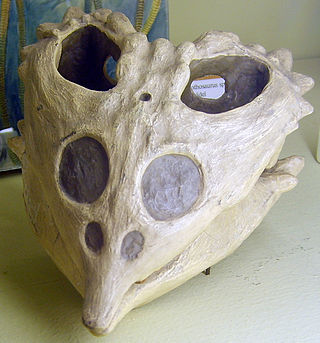
Placochelys is an extinct genus of placodont reptiles erected by Otto Jaekel in 1902.
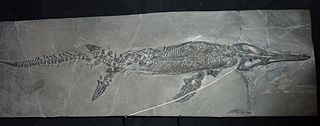
Mixosaurus is an extinct genus of Middle Triassic ichthyosaur. Its fossils have been found near the Italy–Switzerland border and in South China.

Eurhinosaurus is an extinct genus of ichthyosaur from the Early Jurassic (Toarcian), ranging between 183 and 175 million years. Fossils of the aquatic reptile have been found in Western Europe. They used to live in the deep, open sea area. Eurhinosaurus was a large genus of ichthyosaurs. An adult individual could reach up to 7 metres (23 ft) in length.
Platecarpus is an extinct genus of aquatic lizards belonging to the mosasaur family, living around 84–81 million years ago during the middle Santonian to early Campanian, of the Late Cretaceous period. Fossils have been found in the United States and possible specimens in Belgium and Africa. A well-preserved specimen of Platecarpus shows that it fed on moderate-sized fish, and it has been hypothesized to have fed on squid, and ammonites as well. Like other mosasaurs, it was initially thought to have swum in an eel-like fashion, although another study suggests that it swam more like modern sharks. An exceptionally well-preserved specimen of P. tympaniticus known as LACM 128319 shows skin impressions, pigments around the nostrils, bronchial tubes, and the presence of a high-profile tail fluke, showing that it and other mosasaurs did not necessarily have an eel-like swimming method, but were more powerful, fast swimmers. It is held in the Natural History Museum of Los Angeles County. Isotopic analysis on teeth specimens has suggested that this genus and Clidastes may have entered freshwater occasionally, just like modern sea snakes.

Presbyornis is an extinct genus of anseriform bird. It contains two unequivocally accepted species; the well-known P. pervetus and the much lesser-known P. isoni. P. pervetus was approximately the size and shape of a goose, but with longer legs; P. isoni, known from a few bones, was much larger, more than swan-sized. Other fossils, more doubtfully assigned to this genus, are also known.

Palorchestes is an extinct genus of large terrestrial, herbivorous Australian marsupial of the family Palorchestidae, living from the Miocene through to the Late Pleistocene. Like other palorchestids, it had highly retracted nasal region suggesting that it had a prehensile lip, as well as highly unusual clawed forelimbs that were used to grasp vegetation.

Prosqualodon is an extinct genus of Early to Middle Miocene cetacean from Argentina, Australia, New Zealand and Venezuela.

Nyctosaurus is a genus of nyctosaurid pterosaur from the Late Cretaceous period of what is now the Niobrara Formation of the mid-western United States, which, during the time Nyctosaurus was alive, was covered in an extensive shallow sea. Some remains belonging to a possible Nyctosaurus species called N.lamegoi have been found in Brazil, making Nyctosaurus more diverse. The genus Nyctosaurus has had numerous species referred to it, though how many of these may actually be valid requires further study. At least one species possessed an extraordinarily large antler-like cranial crest.
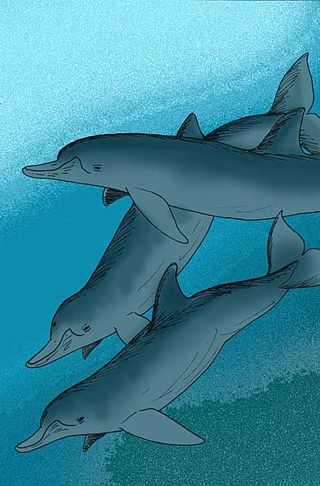
Australodelphis mirus is an extinct Pliocene dolphin. A. mirus is known from fossils found in the Sørsdal Formation, Mule Peninsula, Vestfold Hills, East Antarctica. The genus has been described as an example of convergent evolution with beaked whales.

Xiphiacetus is an extinct genus of cetacean known from the Miocene (early Burdigalian to late Tortonian, 20.43 to 7.246 million years ago of Europe and the U.S. East Coast.

Alopias palatasi, commonly referred to as the serrated giant thresher, is an extinct species of giant thresher shark that lived approximately 20.44 to 13.7 million years ago during the Miocene epoch, and is known for its uniquely serrated teeth. It is only known from such isolated teeth, which are large and can measure up to an excess of 4 centimetres (2 in), equating to a size rivaling the great white shark, but are rare and found in deposits in the East Coast of the United States and Malta. Teeth of A. palatasi are strikingly similar to those of the giant thresher Alopias grandis, and the former has been considered as a variant of the latter in the past. Scientists hypothesized that A. palatasi may have had attained lengths comparable with the great white shark and a body outline similar to it.
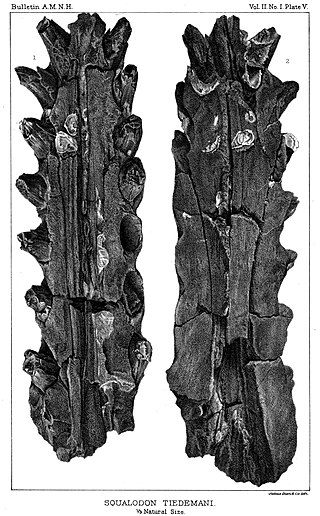
Ankylorhiza is an extinct genus of toothed whale that lived in what is now the United States during the Oligocene epoch, between 29 and 23.5 million years ago. The type and only known species is A. tiedemani, though two fossil skeletons may represent an additional, second species within the genus. Ankylorhiza was about 4.8 meters (16 ft) long, with a long, robust skull bearing conical teeth that were angled forwards at the tip of the snout.






















